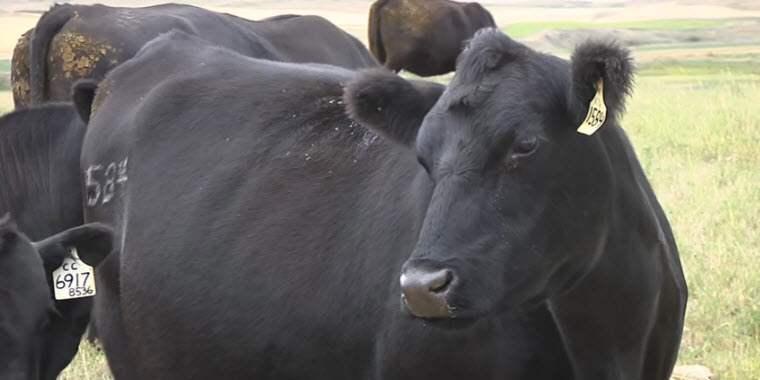by Taylor Grussing, SDSU Extension Cow/Calf Field Specialist
It’s that time of year when driving along the countryside or sitting in the sale barn cows start to show up with an “O” drawn on her side as the Veterinarian called her open on pregnancy check day. While no one likes to see these cows go, if a calf is not going to be born and weaned the next year, she must be marketed in order to pay the feed bills. The earlier open cows are identified, the more savings are seen on winter feed costs in the main herd. Yet, open cows don’t always mean money is lost. Yes, she isn’t going to wean a calf next year, but if the pencil is put to the paper and marketing plans are implemented soon enough, open cows may still provide some profit going into the winter.
Marketing
The decisions to contemplate when marketing open cows include: selling right away, intensively feeding for a period of time before collecting a check, or breeding for a fall calving herd and marketing to a fall operation. The seasonal low for open/cull cow sales occurs in late fall to early winter (October to January). Therefore, in order to increase profit potential, try to identify and sell open cows before October or design a feeding plan that will add weight and set them up for sale after February.
Breakeven
Create a breakeven to determine if it may be more profitable to feed open cows then sell today. Depending on the time of year when cows are identified as open, profit potential will vary. Start by outlining what cows are worth today, what it will cost to feed cows for a few months and what she will weigh when sold. This will give you an idea of where the price needs to be to cover the cost of feeding her and hopefully make a profit.
- Estimated price in November 2017 @ $0.69 x 1300 lbs = $867
- Estimated ADG and feed cost: 3 lbs/day for 90 days @ $1.50/d = 270 lbs and $135
- $867 + $135 = $1002 / 1570 lbs = $0.64/lb
- Estimated breakeven price in February 2018 @ 1570 lbs = $0.64/lb or $64/cwt
According to the Economic Research Service (ERS) Livestock, Dairy and Poultry Outlook for August 2017 forecasted average prices in the third and fourth quarter 2017 to be $67 – 71/cwt and $67 – 73/cwt respectively, with the first quarter of 2018 at $62 – 72/cwt.
Rations for Open Cows
Depending on the desired body weight and condition to be added prior to sale, different feeding regimens can be implemented. Consider cost of feedstuffs and availability of those over the feeding period, as weight needs to be added at a cost-effective rate for profit to be realized.
High Energy
Thin cows will need to go on a high energy ration to begin increase body condition, external fat, intramuscular fat and tenderness at a more efficient rate. Adapt cows from forage ration to a high-energy ration (corn, corn silage, ddgs; 50 Mgal NEg/cwt) over a period of days in order to prevent acidosis. Energy of the ration can continue to increase to 60 – 63 Mcal NEg/cwt over two to three weeks for higher average daily gains. Cows can be fed anywhere from 50 – 100 days but realize feed conversion and average daily gain will vary based on energy in the ration and length of feeding period.
Grazing
In areas where crop residue is plentiful, open cows can graze corn residue at a very low cost. While this will add weight more slowly than high-energy rations, the low expense may work better for some marketing plans. Stocking cows at a rate of 2 acers to head to allow plenty of access to corn residue, paired with a protein supplement to aid digestion may lead to 1.5 lbs of average daily gain.
Fall Herd
Bred females are traditionally worth more than cull cows. By either starting your own fall herd or selling fall bred cows, a fall breeding herd can provide another source of income at a non-traditional time of year due to additional sales of weaned calves when markets are normally increasing. Make sure to take into consideration the additional management, pasture/feeding plans, and labor required to take on a fall calving herd in addition to a spring calving herd before this option is chosen.
Summary
With cull cow receipts generating 15 – 25{b9074abe8f97d35d556dcc91d04f630e2f89dbb1fa8fca20af3e4b7ae12c3e5a} of the revenue in a cow/calf enterprise, it is a critical enterprise that should be managed to spawn profit if possible. The ultimate decision comes down to doing the homework and having a plan in place. Visit with your team of financial advisors to determine the best way to manage open and culls cows this year.
For assistance in open cow feeding and breeding plans or breakeven calculations/marketing plans, contact an SDSU Extension expert.
Photo: NAN


